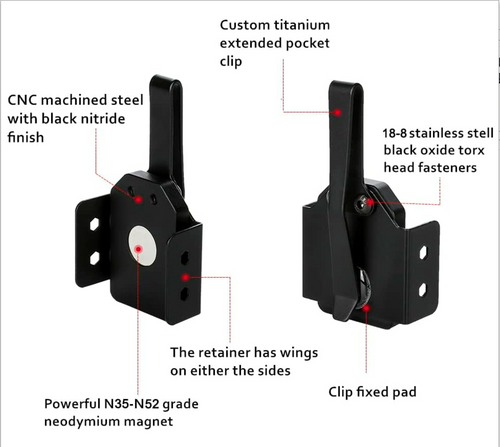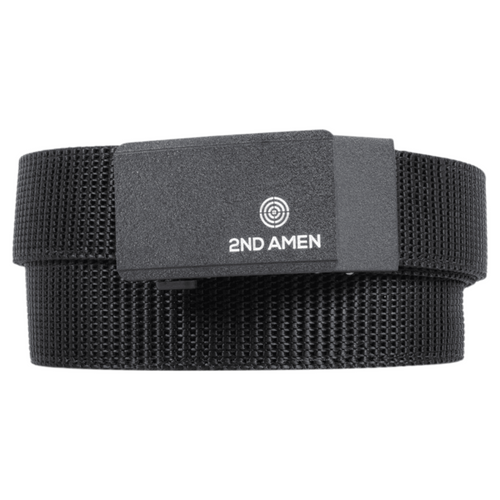The Glock 17 is known for its size, reliability, and accuracy—but concealing it comfortably takes the right setup. If you’ve already found your perfect IWB holster for Glock 17, dialing in your ride height, cant, and wedge can make the difference between awkward carry and all-day comfort. This guide walks through the most effective setup process, using the Breakout 1.0 and Breakout 2.0 IWB Holsters from Houdini Holsters, plus the Tactical Ratcheting Gun Belt that locks everything in place.
Why Glock 17 IWB Holsters Need a Precision Fit
The Glock 17’s full-size frame offers superior control but adds length and grip height, which can print if the holster isn’t adjusted properly. The best IWB holsters for Glock 17 minimize bulk and hug your body through small changes in ride height and angle.
If you’re new to fine-tuning, start with your holster unloaded. Make one adjustment at a time and test the fit seated, standing, and walking. The Breakout 2.0 is especially suited for adjustment thanks to its refined design and rapid draw capabilities.
For broader comfort tips, check out The Most Comfortable IWB Holster for Glock 17—Tested by Real Carriers.

Step 1: Set Your Ride Height
Ride height determines how deep the holster sits inside your waistband.
-
Higher ride height = faster draw, but more grip exposure (more printing).
-
Lower ride height = deeper concealment, but potentially slower access.
For the Glock 17, a medium-low ride height often works best—it balances concealment with a natural grip. The Breakout 1.0 and 2.0 both allow fine-tuned retention and positioning, letting you find that sweet spot.
See how this compares to shorter-frame setups in Best IWB Holsters for Glock 19: Updated Buyer Picks.
Step 2: Adjust the Cant Angle
Cant controls the tilt of the gun grip. The right cant angle can drastically improve concealment and draw ergonomics.
-
Appendix carry (AIWB): keep a neutral cant (0–5 degrees) for a straight draw.
-
Strong-side carry (3–4 o’clock): try a forward cant (10–20 degrees) to tuck the grip closer to your ribs.
The Breakout 2.0 IWB Holster allows micro-angle adjustments so your draw motion feels natural every time. This model was designed to eliminate lag in the traditional “up, press out, aim” sequence, providing a faster, smoother draw.
See the Breakout 2.0 here.

Step 3: Add a Wedge for Better Comfort
A wedge is a small foam or molded insert that pushes the muzzle outward slightly, tilting the grip inward toward your body. This simple addition helps the Glock 17 sit tighter, improving both concealment and comfort.
The Breakout 1.0 and 2.0 already feature a molded contour that reduces printing, but adding a small wedge can make appendix carry significantly more comfortable.
If you’re comparing appendix vs strong-side positioning, review Can You Conceal Carry a Glock 19? for positioning insights that also apply to the Glock 17.
Step 4: Use a Quality Belt to Stabilize Everything
A good holster can’t do its job without a stable belt. The Tactical Heavy Duty Ratcheting Gun Belt provides micro-adjustments so you can change tension with just a click—tighten while standing or loosen when sitting.
This belt prevents the common issue of “holster flop” and helps maintain consistent concealment even with a full-size pistol.
Shop the Tactical Ratcheting Gun Belt here.

Learn more about how a good belt changes your EDC setup in Why a Ratcheting Gun Belt Is the Perfect Partner for Your IWB Holster.
Step 5: Practice Draw and Re-Holster
Once your IWB holster for Glock 17 feels right, practice drawing from concealment in controlled conditions. The Breakout 2.0 offers a faster draw path that saves crucial fractions of a second—ideal for experienced carriers who prioritize speed.
Consistency is key. Practice from a seated position, with cover garments, and while wearing different pants or belts.
If you’re refining your setup, you can revisit The Best IWB Holster for Glock 17: Comfort, Concealment, and Speed.
Houdini Holsters Recommended Setup
-
Holster: Breakout 2.0 IWB Holster for ultimate draw speed and fine-tuned fit
-
Alternative: Breakout 1.0 IWB Holster for reliable comfort and minimalist concealment
-
Belt: Tactical Heavy Duty Ratcheting Gun Belt for micro-adjustable stability
To compare other Glock models, see Glock 26 vs Glock 19: Which Conceals Better with an IWB Holster.
FAQs: IWB Holster for Glock 17
What ride height is best for Glock 17 concealment?
A mid-level ride height gives the best balance between grip access and concealment. Too high exposes the grip; too low slows your draw.
Should I use a claw attachment with a Glock 17 IWB holster?
The Breakout 2.0 is claw-compatible and benefits from it, especially for appendix carry, as it pushes the grip into your body for better concealment.
Can a Glock 17 really be concealed comfortably?
Yes. With a well-adjusted IWB holster, proper cant, and a ratcheting gun belt, the full-size Glock 17 can conceal nearly as smoothly as compact models.
What’s the main difference between Breakout 1.0 and 2.0?
The Breakout 2.0 offers faster access, more customizable angles, and improved comfort through better contouring. The 1.0 remains a great value for budget-conscious carriers.
How tight should my belt be with an IWB holster?
It should be tight enough to prevent movement but not restrict breathing. That’s why the Tactical Ratcheting Gun Belt’s micro-adjustment feature is ideal.
Perfect Your Carry Setup With Our IWB Holster for Glock 17
The best IWB holster for Glock 17 combines security, speed, and all-day comfort. Start with a holster that molds to your carry style—then adjust ride height, cant, and wedge until it feels second nature.
Explore Houdini Holsters’ complete lineup today to lock in your most comfortable and effective EDC setup.
Shop Breakout IWB Holsters | Shop Ratcheting Gun Belts




